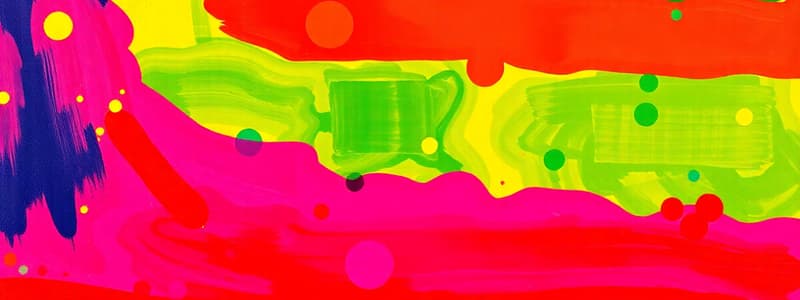Podcast
Questions and Answers
What is the molecular mass of nitrogen trichloride, $NCl_3$?
What is the molecular mass of nitrogen trichloride, $NCl_3$?
- 146.33 u
- 133.39 u (correct)
- 120.36 u
- 77.45 u
What is the approximate mass of a carbon-14 atom, in whole numbers?
What is the approximate mass of a carbon-14 atom, in whole numbers?
- 8 u
- 6 u
- 14 u (correct)
- 12 u
What is the atomic mass of oxygen, given that it is 99.76% oxygen-16 (mass 15.995 u), 0.038% oxygen-17 (mass 16.999 u), and 0.205% oxygen-18 (mass 17.999 u)?
What is the atomic mass of oxygen, given that it is 99.76% oxygen-16 (mass 15.995 u), 0.038% oxygen-17 (mass 16.999 u), and 0.205% oxygen-18 (mass 17.999 u)?
- 16.00 u (correct)
- 17.00 u
- 18.00 u
- 15.99 u
Which of the following is the correct molecular formula for diphosphorus pentoxide?
Which of the following is the correct molecular formula for diphosphorus pentoxide?
What is the atomic mass of lithium, given that it is 92.4% lithium-7 (mass 7.016 u) and 7.60% lithium-6 (mass 6.015 u)?
What is the atomic mass of lithium, given that it is 92.4% lithium-7 (mass 7.016 u) and 7.60% lithium-6 (mass 6.015 u)?
What is the molecular mass of CO_2?
What is the molecular mass of CO_2?
What is the atomic mass of an element that is composed of 60% of an isotope with a mass of 10 u and 40% of an isotope with a mass of 12 u?
What is the atomic mass of an element that is composed of 60% of an isotope with a mass of 10 u and 40% of an isotope with a mass of 12 u?
Which of the following compounds has the lowest molecular mass?
Which of the following compounds has the lowest molecular mass?
What is the atomic mass of an atom with 6 protons and 6 neutrons?
What is the atomic mass of an atom with 6 protons and 6 neutrons?
What is the molecular mass of a molecule of H_2SO_4?
What is the molecular mass of a molecule of H_2SO_4?
Flashcards
Atomic Mass
Atomic Mass
The average weight of an element's isotopes, measured in atomic mass units (u).
Isotope
Isotope
Atoms of the same element with different numbers of neutrons, affecting mass but not chemical properties.
Molecular Mass
Molecular Mass
The sum of the atomic masses of all atoms in a molecule.
Mass Number
Mass Number
Signup and view all the flashcards
Molecular Formula
Molecular Formula
Signup and view all the flashcards
Atomic Mass Unit (u)
Atomic Mass Unit (u)
Signup and view all the flashcards
Weighted Average Atomic Mass
Weighted Average Atomic Mass
Signup and view all the flashcards
Atomic Mass Variance
Atomic Mass Variance
Signup and view all the flashcards
Study Notes
Atomic Masses, Ions, and Ionic Compounds
-
Atomic mass unit (u) is a unit used to measure the mass of individual atoms and molecules.
-
It's defined as one-twelfth the mass of a carbon-12 atom.
-
For macroscopic objects, grams and kilograms are used.
-
Atomic mass of atoms is equal to their mass number.
- Carbon-12 has a mass of 12 u
- Oxygen-16 has a mass of 16 u
-
Atomic mass of elements is taken from the weighted average masses of different isotopes present in their mixture.
-
To calculate an element's atomic mass : multiply the percent abundance of each isotope by the atomic mass of that isotope and sum those values.
Molecular Mass
- The molecular mass of a substance is calculated by summing up the masses of all atoms in the substance.
- This involves:
- Determining the atomic mass of individual atoms from the periodic table.
- Multiplying the atomic mass by the subscript of the atom in the molecular formula.
- Summing up the values obtained in this process.
Ions and Ionic Compounds
- Ions are electrically charged particles.
- Positive ions are called cations.
- Negative ions are called anions.
- Ionic compounds are formed by positive and negative ions.
- Atomic electronic configurations in shells have different levels of energy.
- Lower energy configurations are more stable.
- Noble gases have stable electronic configurations.
Naming Ions
- Cations are named by adding the word "ion" to the end of the element's name.
- Anions are named by adding "-ide" to the stem of the element's name.
Questions
- Questions about molecular masses of substances. Use periodic table to find atomic masses. Questions provide lists of substances (e.g. different molecules, compounds) and ask for their molecular mass.
- Questions related to estimating the mass of isotopes. Questions request estimating the whole number mass of given isotopes. (e.g., hydrogen-1, iron-56, phosphorus-31).
- Questions about calculating atomic mass based on given isotopic composition. Questions provide the isotopic composition (percentage of each isotope) and mass of different isotopes of an element to calculate the average atomic mass of the element.
- Questions to name different ions.
Studying That Suits You
Use AI to generate personalized quizzes and flashcards to suit your learning preferences.




